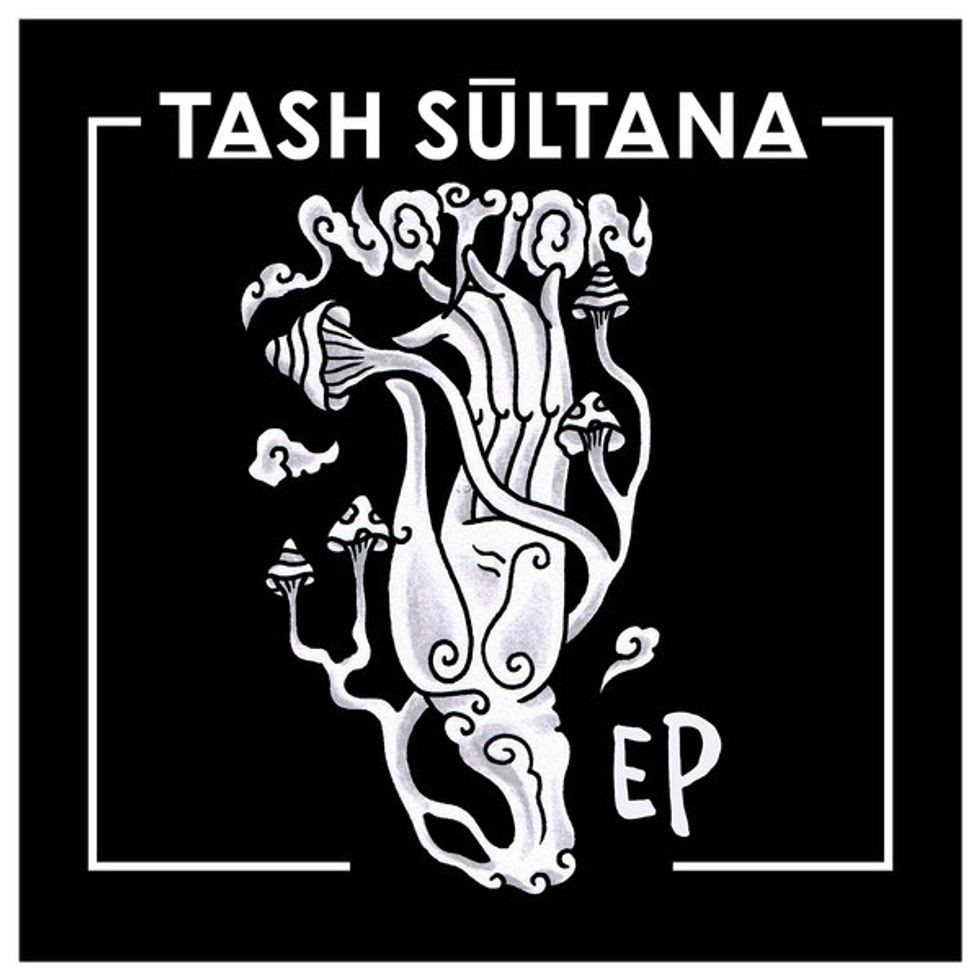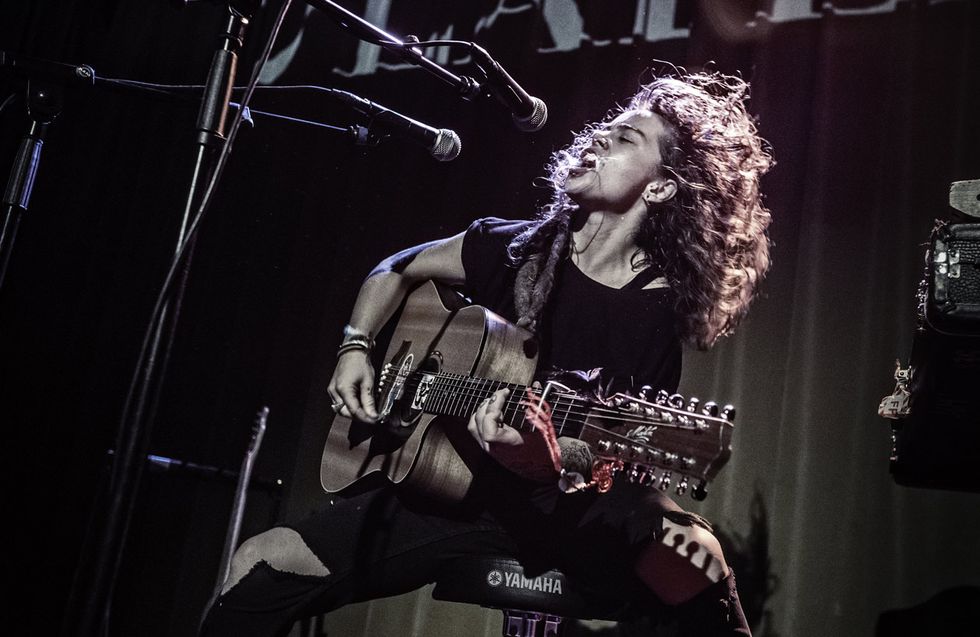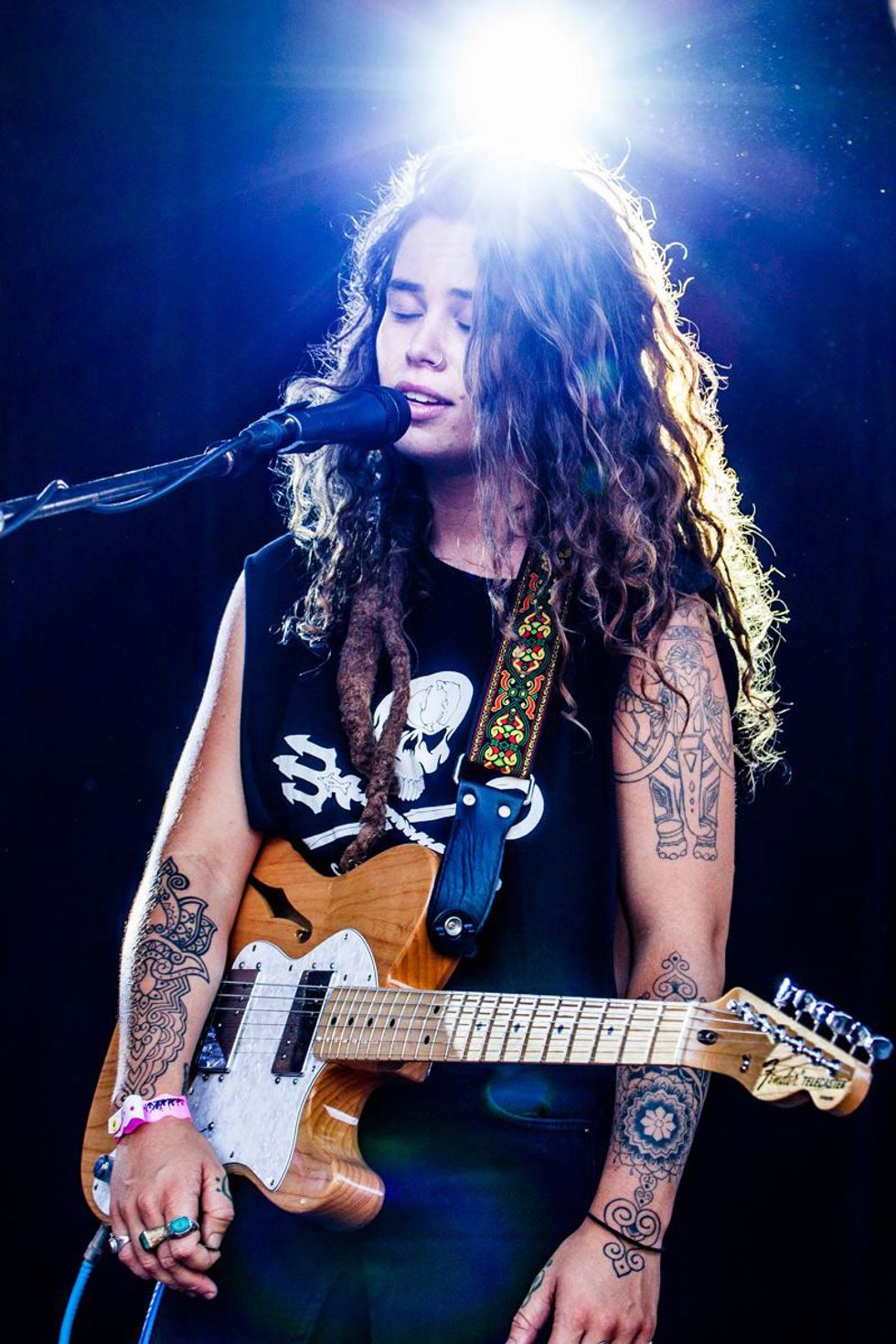Tash Sultana is a self-contained, one-woman band. She generates every sound in every performance, and she does it live, solo, and in real time. “I was in a band for a while,” she says. “But I like doing my own stuff myself. I like the challenge to learn as much as possible on every instrument I pick up.”
Sultana has tons of gear—including multiple guitars, drum machines, a looper, other assorted instruments (including mandolin, flute, and trumpet), and a bevy of pedals—and manipulates those tools while also singing, self-harmonizing, beat-boxing, and layering drum patches. She’s musical—her grooves are heavy and her solos are tasteful—and her songs are structured and cleverly arranged.
Sultana started as a street performer in downtown Melbourne, Australia. She built a small, core following and those fans shared footage of her live performances online that earned her some attention and buzz. She filmed herself at home, too—higher quality clips of complete songs that feature better audio and cute shots of her mother peeking around the corner. “The point is that it’s live,” Sultana says. “You do it as it happens in front of you.” Those videos went viral and millions of views, a string of sold-out shows, and numerous festival appearances later … and Sultana, who is 22 years old, seems poised for something bigger.
What exactly happens next is anyone’s guess, but she’s ready and, regardless, she’ll keep making music. Her artistry transcends the hype—she isn’t a flash-in-the-pan—and her story is compelling.
Music is a ubiquitous presence in Sultana’s life. It’s always been that way. “I gravitated to anything that was an instrument when I was a little kid,” she says. “Anything that made sound, I’d play it. My grandfather bought me a guitar when I was 3 and I started playing then.”
Her father listened to classic rock—bands like Led Zeppelin and Pink Floyd—and hearing those tones was influential early on. “I had things that I was drawn to,” she says. “I like how Lindsay Buckingham plays. He had an original style for the guitar, kind of like Gypsy-rock picking.”
She is also a big fan of Carlos Santana and you can hear his influence in her playing. But better, in April she opened for him. “We just did a show together, which was fucking awesome.”
But Sultana isn’t stuck in the classic sounds of yesteryear. Listening to her music—especially the six songs off Notion, her recent EP—it’s obvious she’s something of a polyglot. She’s internalized everything from reggae and ska to more modern feels like hip-hop and trance.
Apparently it’s a sensibility she absorbed through osmosis because she’s never learned songs or performed covers. “I have never played other people’s songs,” she says. “It’s a waste of time. You could be focusing on the stuff you’re capable of writing. Be your own artist instead of playing somebody else’s songs.”

Although Sultana has indie-rock history in the band MindPilot, last fall’s release of her debut EP, Notion, put her on the world’s stages, including a tour opening for Carlos Santana.
Although if you search the internet, you will find one—just one—a cover of MGMT’s “Electric Feel,” which she did for Triple J, an Australian radio station. “They do this thing called ‘Like a Version,’” she explains. “You do a cover of somebody’s song and completely change it up. That’s the only song I’ve covered. I wouldn’t do it again. I gave it a shot, but it’s not my thing. I like to do my own stuff.”
Her thing is jamming.
Jamming is intrinsic to how she operates. It’s how she practices, composes, and gets familiar and reacquainted with her pedalboard. It’s the bedrock of her relationship to music. “I just jam and let whatever happens happen,” she says. “I pick up different sounds along the way. I hunt them down and find them.”
But as fundamental as jamming is to her approach, she isn’t a flake. Her jamming is directed and purposeful—and she is hyper-focused when working on something new. “I don’t listen to any music at all, so that I really hear what I am doing,” she says about songwriting. “I’ll have a jam, record it, play it for a week at a time, and it will be the only song I listen to. It drives me nuts, but I hear it properly.”
Sultana’s live performances are a synthesis of that open-ended, improvisatory aesthetic combined with personal discipline and a commitment to serving the song. Her music has room to breathe, which explains why her songs aren’t short, 3-minute nuggets (they average from about 5 to 9 minutes each) and change from night to night. Part of that is the nature of the beast: layering live loops takes time and each part needs to be played and captured. But her songs also aren’t endless solos over infinite vamps. They have definite structures, chord progressions, abrupt changes, and contrasting sections. She’s a songwriter, albeit one who’s loose and jam-centric.
Although Sultana’s main modus operandi is to layer electric guitars and stacks of effects, she’s also a killer acoustic player. Here, she puts some voodoo on her Maton 12-string. Note the multiple microphones for routing vocal effects.
Photo by Ben Houdijk
Though Sultana cultivated her initial audience busking in Melbourne, she doesn’t play on the street anymore. “I haven’t busked for about two years,” she says. “It is too dangerous. I get people following me home and shit.” She didn’t try out the streets of different cities once she hit the road either. “I don’t have the time to do that. I’d rather play big theaters than be busking in the day. I love busking, but I’ve worked so hard to get where I am getting to—to where I really want to be—which is that nice proper production, in big theaters and small stadiums, and stuff like that. I want to put on a real show.”
That real show still maintains its edgy street vibe, however. Rather than using saved, stored, or prerecorded loops, she plays them fresh, night after night. “I do not play to a backing track,” she says. “I’m anti backing tracks.”
Onstage, Sultana may be anti backing tracks, but her approach to recording is something altogether different. In the studio, her process is arduous, if not painful. “Every layer that I do live I individually track with the multi-track in the studio. I ended up with literally 75 tracks on one song.”
Her approach to sculpting guitar tones is no less particular. “I’ll do a quad-amp setup,” she says. “It’s four amps at the end of the room facing each other, and I set up mics around them.” Those four amps include a 1952 Vox, an Orange head with matching cab, and a Fender Deluxe Reverb (she doesn’t remember what the fourth amp is and didn’t provide more specifics about the other three). She uses a pedal—the Palmer Triage Amp Selector—which sends her signal to three amps and makes it easy to choose between one or a combination of amps. At the board, she crafts a composite guitar tone using a combination of close mics, room mics, and overheads.
That’s similar to how she records vocals as well. “It is an absolute fuck-load of microphones,” she says. “I like picking up the sound of the space that I’m using, and then trying to add in effects later.”
But Sultana doesn’t bring four amps on the road. She doesn’t even bring one amp on the road. “I don’t use an amp live,” she says. “Too much bottom end comes through and amps don’t work with drum samples. It doesn’t sound as good for how I’ve set my stuff up.”
Sultana’s sense of time—in terms of groove and her pedalboard choreography—is impeccable. True, if you watch enough live clips you may occasionally spot a glitch, but for the most part, she nails it. Her groove is in the pocket and her device manipulation is masterful. It’s something organic: the product of years of shedding, and something she intuits.
away my stuff.”
She doesn’t use a click track when performing live, although on a rare occasion she may use one in the studio. “I use my foot,” she says. “I just use the common thing of tapping my feet. In the studio I will use a click to make sure it’s like, spot on—you kind of have to—but I find that I end up 90 percent just playing without it. I can stay in time without a click.”
Her looper of choice is the Boss RC-30 Loop Station. “I’ve tried different loopers but I just don’t get the same feel,” she says. Her guitars, drum samples, and other instruments run into the RC-30, and from there to the house PA. Vocals are kept on their own. “Vocals have nothing to do with my looping. They run on separate channels on a completely separate pedalboard.”
Speaking of pedalboards, Sultana’s is massive. “I have 39 different pedals,” she says.
What are those 39 pedals? PG readers want to know.
“They’re all secrets.”
Secrets?
“I never give away my stuff.”
Why not? I pushed, but that was all she’d say.
But at least Sultana has no problem talking about guitars. “I have so many,” she says. “I’ve got a Fender Jag, three Strats, and about five or six Telecasters. I’ve got some antique acoustic guitars that have only four-digit serial numbers.” On tour, she travels with a Fender Stratocaster, a handful of Telecasters, and a Maton SRS70C/12 acoustic-electric 12-string. Her fragile, antique instruments stay home.
And if layering multiple guitar parts, beat-boxing, and singing weren’t enough, Sultana also boasts killer acoustic chops. Check out her recent performance on NPR’s Tiny Desk Concerts. In addition to her mind-blowing looping, we see her perform as a solo acoustic guitarist with a complete command of such advanced techniques as two-handed tapping and hyperactive hammer-ons. She also does it on an 11-string acoustic—the G string doesn’t have the high octave—although that isn’t on purpose. “It just breaks,” she says. “It is the most common string that I break. If it’s broken, I won’t put it back on. I don’t really care.”
Put the pieces together and that’s a snapshot of Tash Sultana—a young, uncompromising, music-obsessed talent. “That’s all I know how to talk about,” she says. “I want to take it as far as I can.”
YouTube It
Watch Tash Sultana at work in this home version of her song “Jungle,” from her debut EP Notion, which also displays her considerable vocal abilities. The guitar is, obviously, a Fender Jazzmaster. The breed of the dog that appears at 2:57 is unknown.
Jamming is intrinsic to Sultana’s art—even onstage, where she builds all her songs from scratch, starting with loops and drum patterns, then adding vocals, melodies, textures, and solos. Photo by Alicia Fox
Tash Sultana’s Stage and Studio Secrets
Tash Sultana doesn’t talk about her pedalboard—other than discussing her use of the Palmer Triage Amp Selector as the main router for her guitar’s signal in the studio, where she employs four amplifiers. However, her touring guitars include a Fender Stratocaster, assorted Fender Telecasters, and a Maton SRS70C/12 12-string acoustic. Stage amps? Live, she don’t need no stinkin’ amps! And her strings are Dunlop (.010–.052) and, for the 12-string, Elixir (.011–.052). Sultana uses Dunlop .73 mm picks.

















![Rig Rundown: Russian Circles’ Mike Sullivan [2025]](https://www.premierguitar.com/media-library/youtube.jpg?id=62303631&width=1245&height=700&quality=70&coordinates=0%2C0%2C0%2C0)
















![Rig Rundown: AFI [2025]](https://www.premierguitar.com/media-library/youtube.jpg?id=62064741&width=1245&height=700&quality=70&coordinates=0%2C0%2C0%2C0)




















 Zach loves his Sovtek Mig 60 head, which he plays through a cab he built himself at a pipe-organ shop in Denver. Every glue joint is lined with thin leather for maximum air tightness, and it’s stocked with Celestion G12M Greenback speakers.
Zach loves his Sovtek Mig 60 head, which he plays through a cab he built himself at a pipe-organ shop in Denver. Every glue joint is lined with thin leather for maximum air tightness, and it’s stocked with Celestion G12M Greenback speakers.






